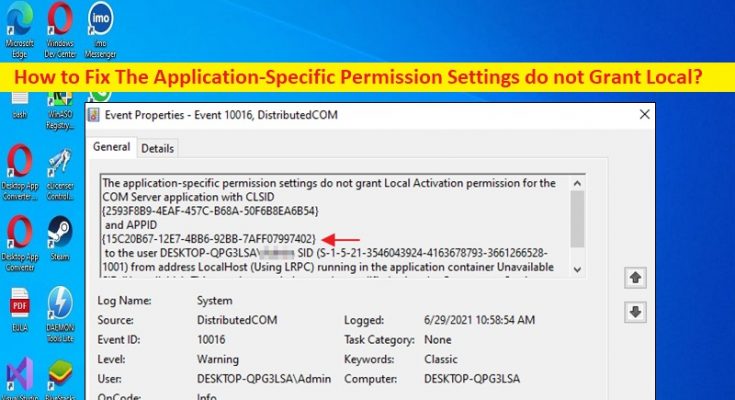What is ‘The Application-Specific Permission Settings do not Grant Local Activation Permission for the COM Server Application’ error in Windows 10/11?
In this article, we are going to discuss on How to fix The Application-Specific Permission Settings do not Grant Local Activation Permission for the COM Server Application error in Windows 10/11. You are provided with easy steps/methods to resolve the issue. Let’s starts the discussion.
‘The Application-Specific Permission Settings do not Grant’ error:
It is common Windows Problem considered as Windows Event Viewer’s System logs issue. This issue is usually occurred when Microsoft Components in your Windows 10/11 computer trying to access DCOM Components without the required permissions. The error is known to occur on Windows 10/11, Windows Server 2019, or Windows Server 2016. The error is appeared with ‘Event ID 10016’or ‘DistributedCOM(DCOM) Errors Event ID:10016’ error in Windows Event Viewer app in your Windows computer.
This issue is occurred when a specific process doesn’t have enough permissions to access the DCOM components that are indicated in event log. So, you can provide all the required permission to DCOM components in your device to fix the issue. If you are facing the same issue and searching for ways to fix the issue on the web, then you are in right-place for the solution. Let’s go for the solution.
How to fix The Application-Specific Permission Settings do not Grant Local Activation Permission for the COM Server Application error in Windows 10/11?
Method 1: Fix ‘The Application-Specific Permission Settings do not Grant – DistributedCOM(DCOM) Errors Event ID:10016’ error with ‘PC Repair Tool’
‘PC Repair Tool’ is quick way to find and fix BSOD errors, DLL errors, EXE errors, problems with programs/applications, malware or viruses infections in computer, system files or registry issues, and other system issues with just few clicks.
Method 2: Provide required permission to DCOM Components
One possible way to fix the issue is to provide required permissions to DCOM components in your device.
Step 1: Open ‘Registry Editor’ app in Windows PC via Windows Search Box and go to following path
HKEY_CLASSES_ROOT\CLSID\{D63B10C5-BB46-4990-A94F-E40B9D520160}
Step 2: Double-click ‘Default’ key in right-pane and note down ‘Value Data’ listed and go to following path
HKEY_CLASSES_ROOT\AppID\{9CA88EE3-ACB7-47C8-AFC4-AB702511C276}
Step 3: Right-click on ‘{9CA88EE3-ACB7-47C8-AFC4-AB702511C276}’ key, and select ‘Permissions’ option

Step 4: In the opened window, click ‘Advanced’ tab and click ‘Change’ option next to ‘Owner’ heading, and click ‘Object Type’ heading and select ‘Users’
Step 5: Click ‘Location’ button and select your ‘Desktop (Name)’, enter the username of your account, and then hit ‘Ok > Apply’ to save the changes
Step 6: Now, click ‘ok’ on window close it and open ‘Permissions’ window that you launched earlier, and click ‘Administrators’ in ‘Group or User Names’ heading, and check ‘Full Control’ option

Step 7: Select ‘Users’ and check ‘Full Control’ option again, and hit ‘Apply > Ok’ to save the changes and close window
Step 8: Now, press ‘Windows + R’ keys on keyboard, type ‘dcomcnfg.exe’ in ‘Run’ window and hit ‘Ok’ button and expand the following options
Component Services>Computers>My Computer>DCOM Config
Step 9: Right-click ‘RunTime Broker’ option in right-pane, and select ‘Properties’
Step 10: If the AppID listed there matches with AppID ‘“9CA88EE3-ACB7-47C8–AFC4–AB702511C276” in the error it means that you have selected the right instance of the application.’
Step 11: Click ‘Security’ tab, and check ‘Customize’ option for ‘Launch and Activation Permissions’
Step 12: Click ‘Edit’ button and click ‘Remove’ button if there is Windows Security prompt
Step 13: Now, click ‘Add’ button, type ‘NT AUTHORITY/LOCAL SERVICE’ in ‘Enter objects Name to select’, and then hit ‘Ok’ and grad the ‘Local Activation’ permission to entry
Step 14: Once done check if the issue is resolved.
Conclusion
I hope this article helped you on How to fix The Application-Specific Permission Settings do not Grant Local Activation Permission for the COM Server Application error in Windows 10/11 with easy steps/methods. You can read & follow our instructions to do so. That’s all. For any suggestions or queries, please write on comment box below.



